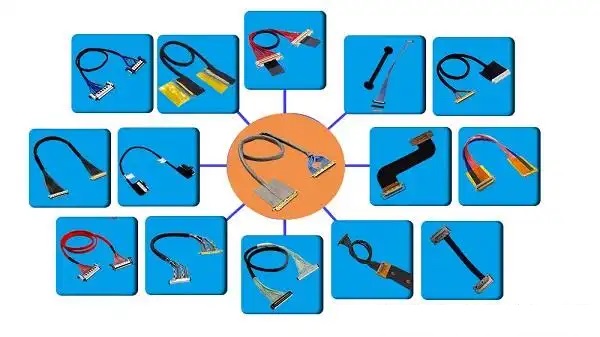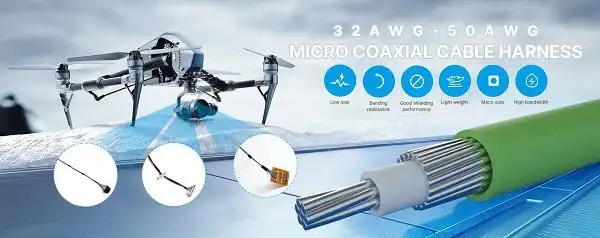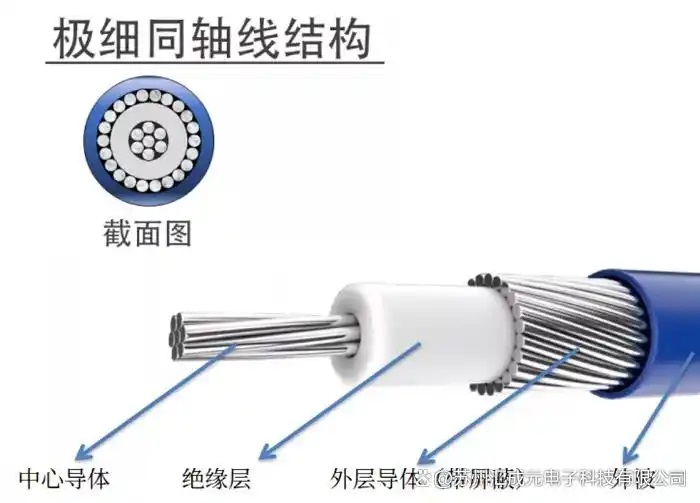In modern electronic devices, the speed of signal transmission is closely related to system performance. Whether it is 4K/8K ultra-high-definition display, VR/AR virtual reality, autonomous driving image systems, or slim laptops and medical detection equipment, the demand for data transmission bandwidth and stability is increasingly high. Behind these applications, a cable with an outer diameter of only hundreds of micrometers—the ultra-thin coaxial cable—is quietly becoming the core channel for high-speed signal transmission. With its characteristics of miniaturization, high-speed rate, and low crosstalk, it is gradually replacing traditional ribbon cables and flexible cables in the high-end electronic field, becoming the ideal choice for achieving high-speed connections in compact spaces. So, how fast can such a "fine as hair" cable transmit? Where is its speed limit? Let us explore together.

What is an extremely fine coaxial beam?
Micro coaxial cable is a type of cable that is structurally similar to standard coaxial cable but is more miniaturized in size. Its outer diameter is typically between 0.3mm and 1.0mm, consisting of a central conductor (core), insulation layer, shielding layer (copper braid or aluminum foil), and outer sheath. This compact and efficient structure can significantly reduce signal interference and enhance signal integrity, enabling stable and high-speed data transmission even in limited spaces. Today, it is widely used in high-definition camera modules, laptops, drones, medical equipment, and internal connections in high-end consumer electronics.

What is transmission rate?
In the field of electronics and communication, transmission rate (Data Rate / Transmission Speed) refers to the amount of data transmitted through a signal channel per unit of time, usually represented in bps (bits per second).
Common conversion relationships are as follows:
• 1 kbps = 1,000 bps
• 1 Mbps = 1,000 kbps
• 1 Gbps = 1,000 Mbps
For example, 1Gbps equals the transfer of one billion bits per second. The higher the transmission rate, the more data it can carry within a unit of time, which is particularly suitable for high bandwidth demand scenarios such as high-definition video transmission, VR/AR interaction, high frame rate gaming, and real-time image processing.

How fast can a very fine coaxial cable transmit?
Current mainstream speed
According to the current mainstream specifications, the transmission rate of Micro Coaxial Cable generally reaches 3Gbps to 6Gbps per channel, while high-end models can achieve 10Gbps to 16Gbps per channel. For example, a 36AWG Micro Coaxial Cable (30cm in length) can reach a maximum single-channel rate of 12Gbps; if used for a camera module with a 4 Lane MIPI CSI-2 structure, the overall multi-channel transmission rate can exceed 40Gbps.
Theoretical Limiting Speed
From the perspective of signal integrity and structural characteristics, the theoretical transmission limit of Micro Coaxial Cable is mainly influenced by the following factors:
• Wire diameter size (AWG value)
• Design and quality of shielding layer
Medium material and thickness
Cable length
Connector and termination loss
Under high-quality materials, short distances (<50cm), and excellent EMI control conditions, the single-channel data rate is expected to exceed 20Gbps. Currently, some laboratories and customized high-end products have already achieved short-distance high-speed transmission performance of 28Gbps per channel.

Why can ultra-fine coaxial cables achieve high transmission rates?
Micro Coaxial Cable can achieve high-speed transmission in extremely small spaces, mainly due to the following technical advantages:
Coaxial structure design: With good impedance control (commonly 50Ω or 75Ω), it can effectively suppress crosstalk and enhance signal integrity.
Excellent electromagnetic shielding performance: multi-layer woven or aluminum foil shielding structure ensures extremely low EMI radiation and interference.
Supports various high-speed protocols: compatible with MIPI D-PHY / C-PHY, eDP 1.4/1.5, HDMI 2.1, USB4 / Thunderbolt, DisplayPort 2.0 and other high-speed interface standards.

With excellent electrical performance, stable impedance characteristics, and excellent EMI control capabilities, ultra-fine coaxial cable束 has become one of the key solutions for high-speed signal transmission. Currently, its mainstream transmission speed range is from 3Gbps to 16Gbps, with high-end models able to exceed 20Gbps and even higher. With the rise of high-bandwidth applications such as 4K/8K ultra-high-definition display, VR/AR, autonomous driving, and high-speed image transmission, the market demand for Micro Coaxial Cable and technological innovation will continue to accelerate.
We have been focusing on the design and customization of high-speed cable harnesses and extremely thin coaxial cable harnesses for a long time, committed to providing stable and reliable high-speed interconnection solutions. If you have any related needs or want to learn more, please contact: Manager Zhang.
18913228573 (WeChat same number).




